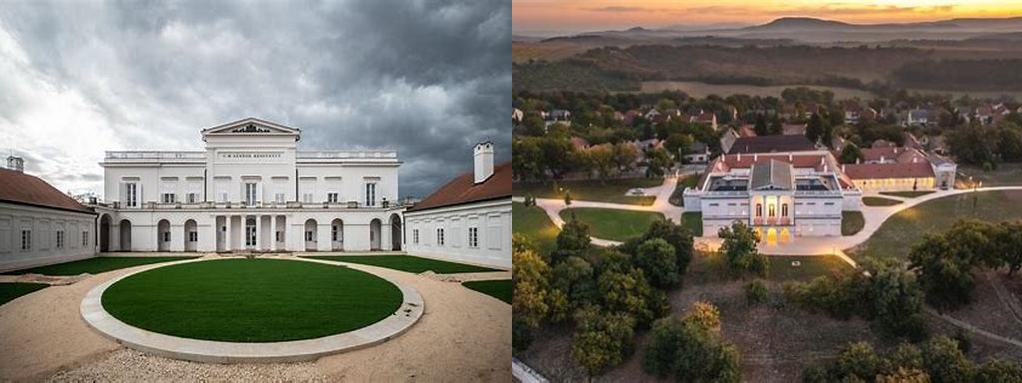
Sándor-Metternich-vadászkastély—the name might sound like an enchanting mouthful, but this hidden gem settled in the quaint village of Gyermely is one of those places in Hungary that manages to whisk you away from the daily grind and gently immerse you in the world of aristocratic leisure and natural serenity. Nestled in the rolling hills of northwest Hungary, about 40 kilometers from Budapest, the lodge feels refreshingly distant from urban routine, offering both history buffs and countryside wanderers a taste of something unique and quietly grand.
An interesting fact about the Sándor-Metternich Hunting Lodge is that it pulls its double-barrelled name from two legendary aristocratic families who have left their mark on central Europe: the Sándors, a Hungarian noble family whose roots stretch deep into the nation’s history, and the Metternichs, a name most often associated with the diplomatic mastermind, Klemens von Metternich—though it was his descendants who were actually involved here. The story of the lodge begins in the early 1800s when Count Móric Sándor, a charismatic noble, started developing these lands as a hunting estate and rural retreat. The current building, a dignified yet inviting mansion, is the legacy of a time when Hungarian aristocracy sought the pleasures of the countryside—a time echoed in every creak of the wooden floors and every elegantly faded wallpaper.
Arriving at the estate, the first thing that steals your attention is its stately—though not overwhelming—architecture. The lodge’s facade has an air of old-world restraint: classical lines, light-toned walls, and windows thoughtfully positioned to catch the golden rays filtering through ancient oaks. The entrance opens into a warm foyer where echoes of hunting boots and laughter seem to linger from centuries past. Though not sprawling like Versailles, there’s a sense of scale here that allows imagination to roam: drawing rooms fit for lively conversations, dining halls designed to host sumptuous feasts, and corridors lined with antlers and noble family portraits that silently narrate tales of games and gatherings.
But don’t expect high-stakes, polished opulence or soulless luxury. The magic of the Sándor-Metternich Hunting Lodge lies in its sense of nostalgia and genuineness. Unlike so many European aristocratic homes turned museums, here the atmosphere remains approachable, as if Count Móric Sándor himself might stroll by in riding boots, ready for a day out fox-hunting or simply wandering the estate’s paths. There’s also a good deal of charming decay, the sort that reminds you that real people lived, loved, and aged within these walls. The estate’s size is perfectly manageable for a day-trip stroll; wandering from one room to another, you’ll find display cabinets of hunting trophies and period furniture that make the stories of the place suddenly, comfortingly real.
Outdoors, the true soul of this lodge is the landscape. Once reserved for privileged hunting parties, the surrounding woodlands and meadows now invite all walk-ins for lazy rambles or back-to-nature experiences. There’s something captivating about the parklands: the way sunlight dances between old chestnut trees, the unpredictable movements of deer in the underbrush, the sense that all this green space has, for centuries, been a silent witness to grand adventures and whispered secrets. If you’re lucky to arrive during autumn, you’ll catch the landscape painted in fiery golds and reds, the air crisp and fragrant, steeped in that melancholy beauty that tells you why so many poets loved the countryside.
Beyond the lodge walls and forested corners, Gyermely itself is quietly endearing. The village, known for its relaxed charm and slow tempo, is also famous for its pasta factory, so it’s not uncommon to catch a faint aroma of durum wheat drifting on the breeze. After exploring the hunting lodge, you can stop at a rustic local eatery to sample traditional Hungarian dishes or simply while away the time people-watching in the village square.
The Sándor-Metternich-vadászkastély is not a bucket-list heavyweight like the grand palaces of Vienna or Budapest, but it offers something their marble corridors can’t: a sense of intimacy, a real touch of storybook history, and a rich blend of Hungarian and Central European tradition. It is here, among the muted echoes of aristocratic leisure and the gentle hush of oak-draped trails, you are reminded why travelers seek not just sights, but stories—and why the quiet places, too, are worth every step off the beaten path.





